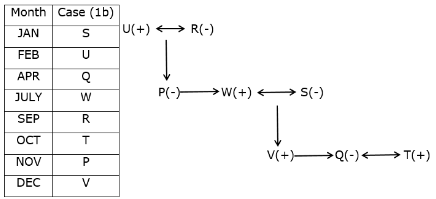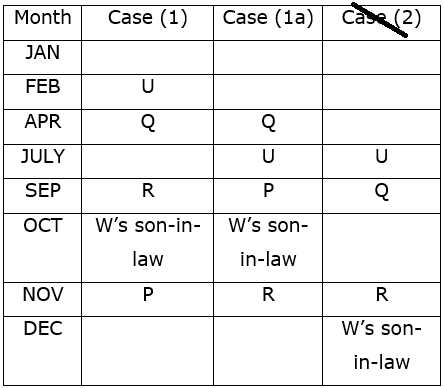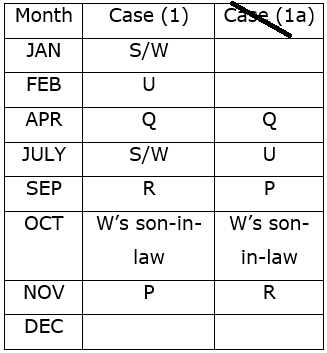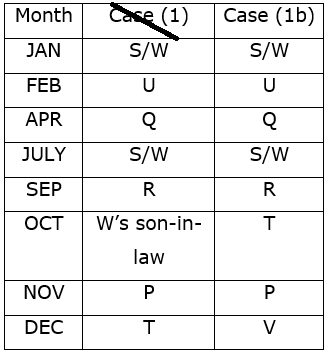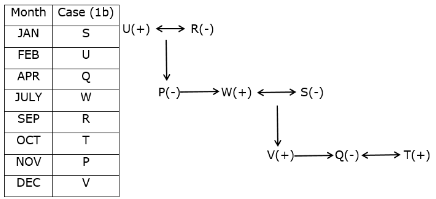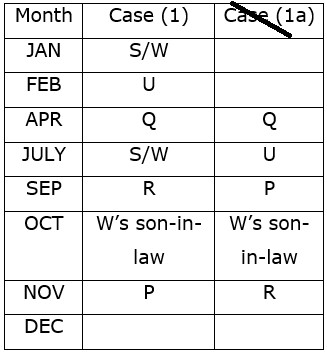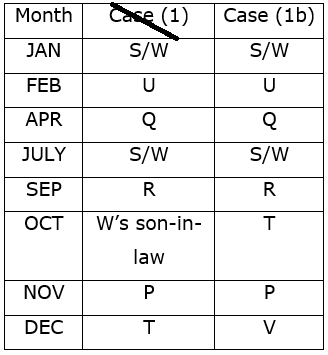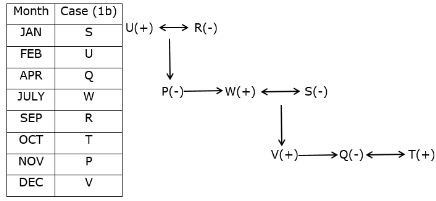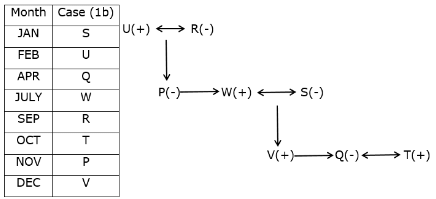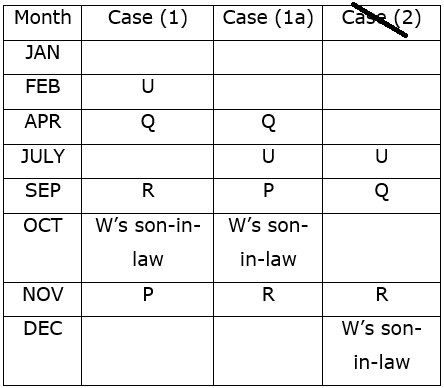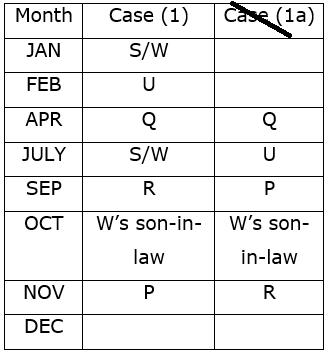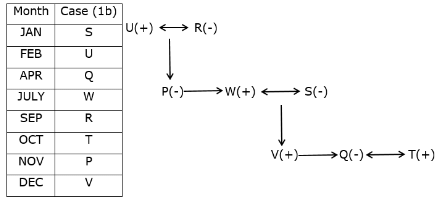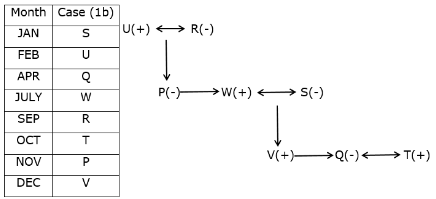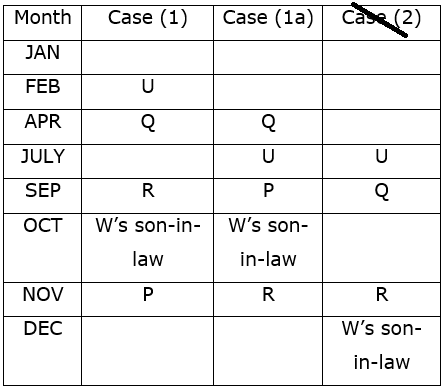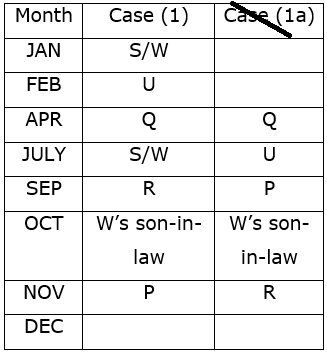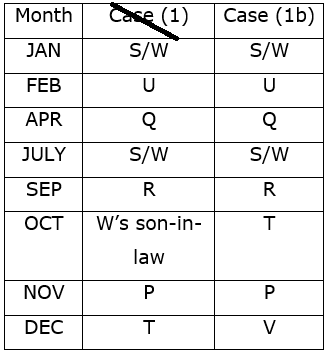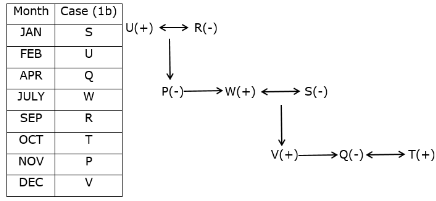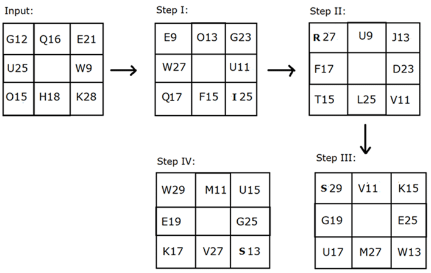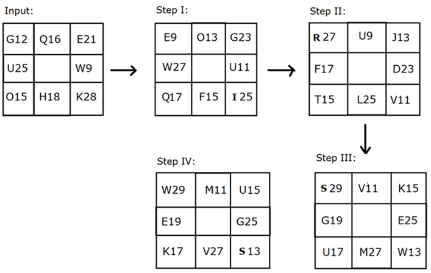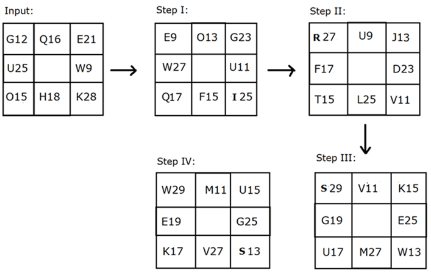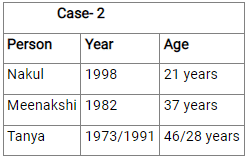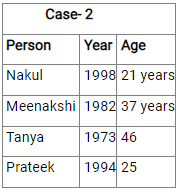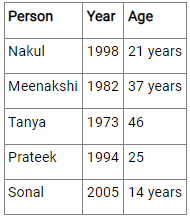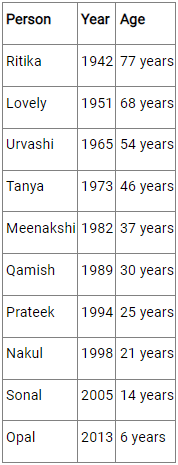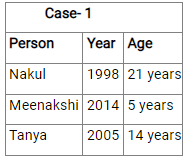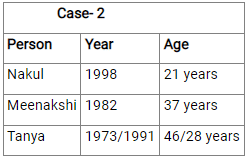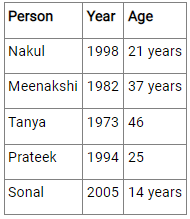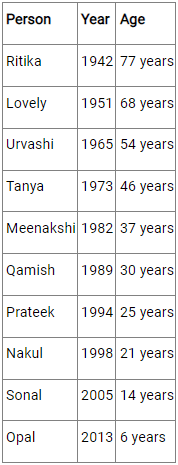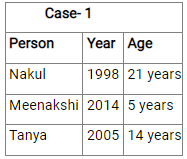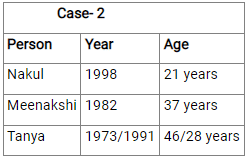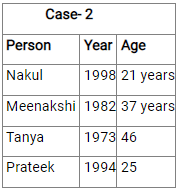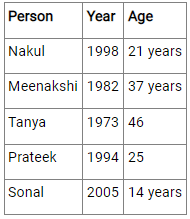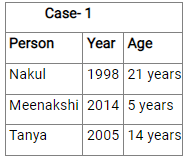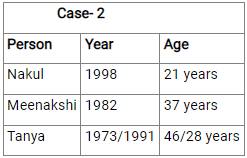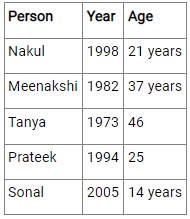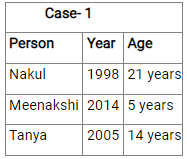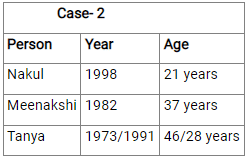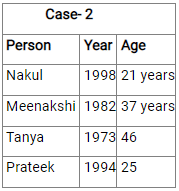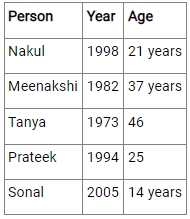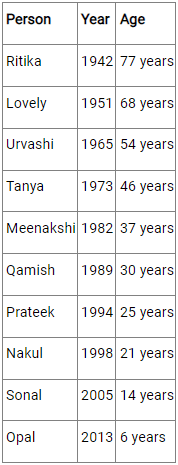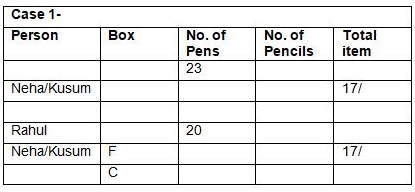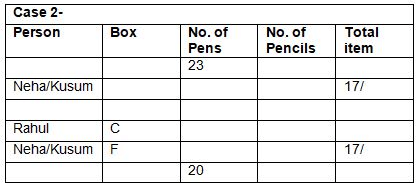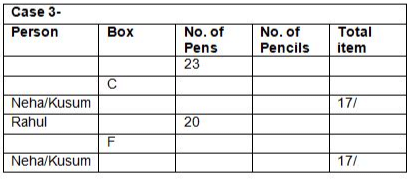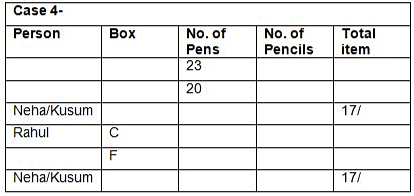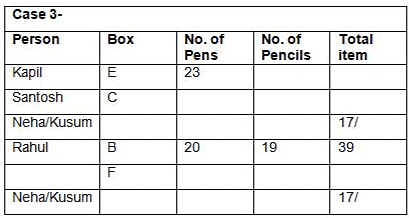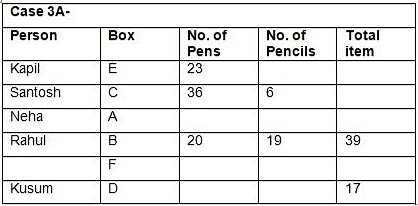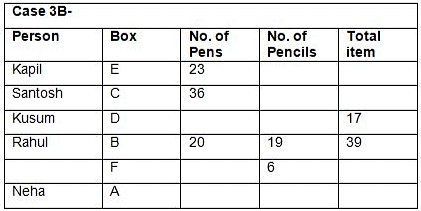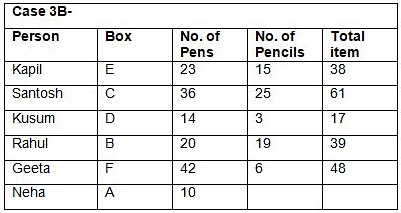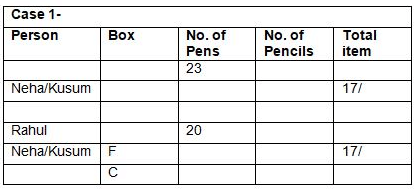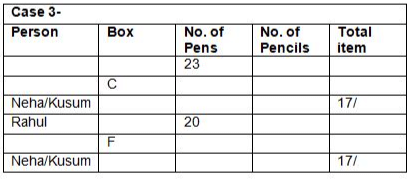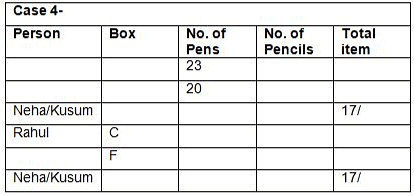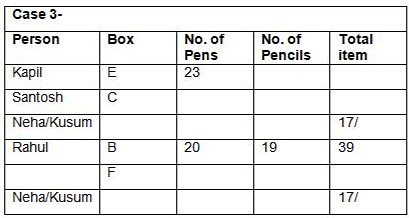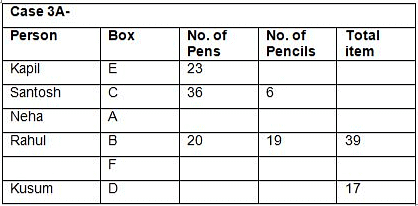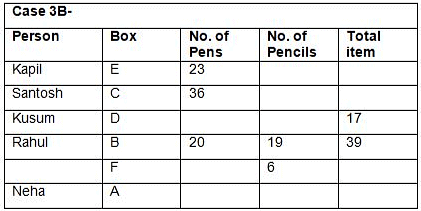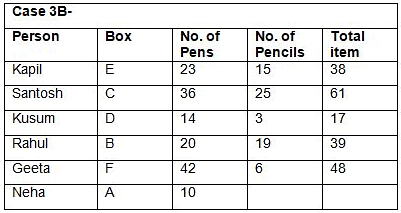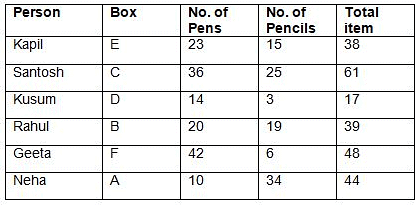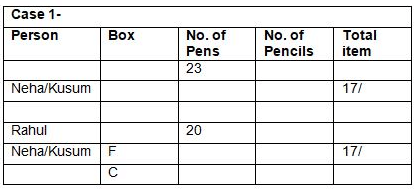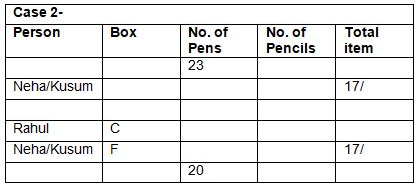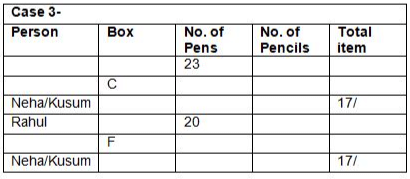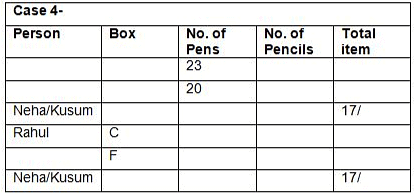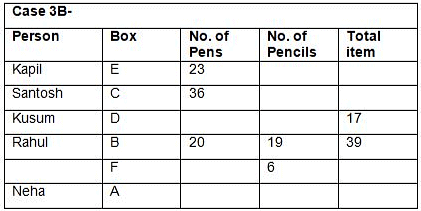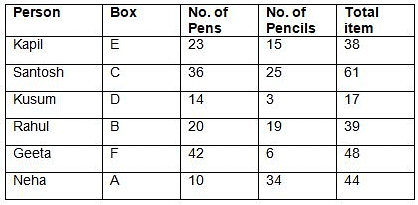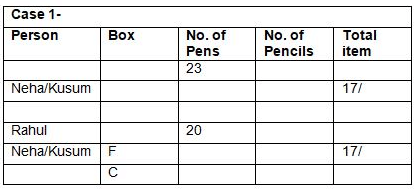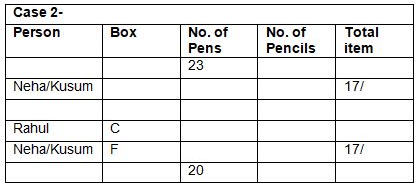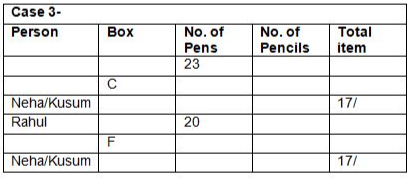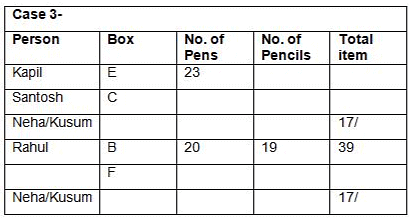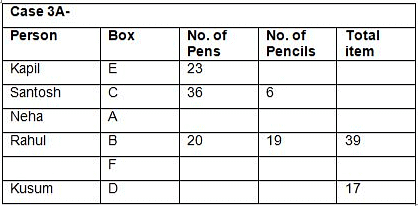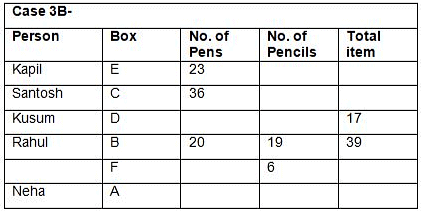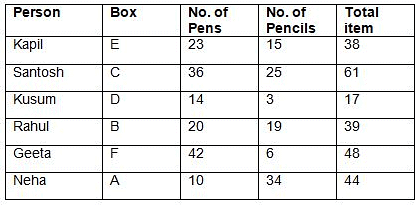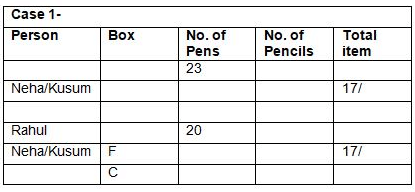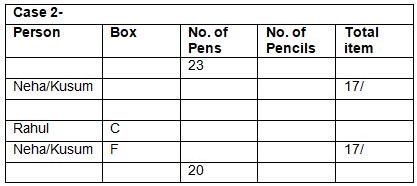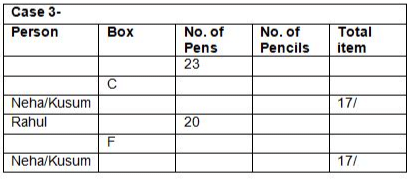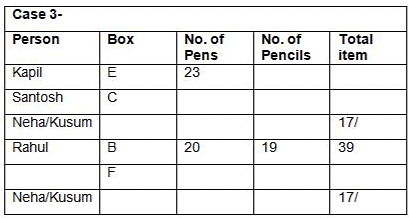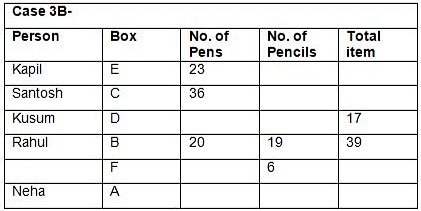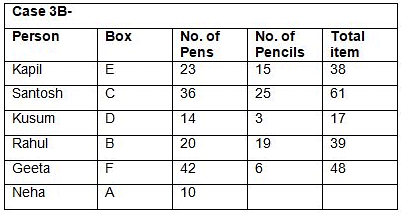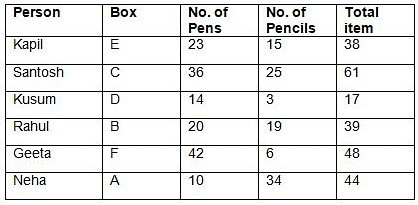SBI PO Mains Mock Test - 7 - Bank Exams MCQ
30 Questions MCQ Test - SBI PO Mains Mock Test - 7
Directions: Study the following information carefully and answer the below questions.
Eight persons – P, Q, R, S, T, U, V, and W from three generations family get promoted in different months viz.- January, February, April, July, September, October, November, and December of the same year but not necessary in the same order.
U promoted three persons before R, who is the mother of W. Q is the only daughter of P’s brother and is promoted in a month having 30 days. W’s son-in-law promoted three persons after Q. The number of persons promoted before U is the same as the number of persons promoted after P. Q is neither promoted immediately before nor after R, who is not promoted in December. Two persons are promoted between S and W, who is the father of V. V is an unmarried member of the family. Q’s father is the only son of the one who promoted four persons before T. P’s father is promoted immediately after U’s daughter-in-law.
Q. How the one who was promoted in November is related to Q?
Directions: Study the following information carefully and answer the below questions.
Eight persons – P, Q, R, S, T, U, V, and W from three generations family get promoted in different months viz.- January, February, April, July, September, October, November, and December of the same year but not necessary in the same order.
U promoted three persons before R, who is the mother of W. Q is the only daughter of P’s brother and is promoted in a month having 30 days. W’s son-in-law promoted three persons after Q. The number of persons promoted before U is the same as the number of persons promoted after P. Q is neither promoted immediately before nor after R, who is not promoted in December. Two persons are promoted between S and W, who is the father of V. V is an unmarried member of the family. Q’s father is the only son of the one who promoted four persons before T. P’s father is promoted immediately after U’s daughter-in-law.
Q. Which of the following statement is true with respect to S’s husband?
Directions: Study the following information carefully and answer the below questions.
Eight persons – P, Q, R, S, T, U, V, and W from three generations family get promoted in different months viz.- January, February, April, July, September, October, November, and December of the same year but not necessary in the same order.
U promoted three persons before R, who is the mother of W. Q is the only daughter of P’s brother and is promoted in a month having 30 days. W’s son-in-law promoted three persons after Q. The number of persons promoted before U is the same as the number of persons promoted after P. Q is neither promoted immediately before nor after R, who is not promoted in December. Two persons are promoted between S and W, who is the father of V. V is an unmarried member of the family. Q’s father is the only son of the one who promoted four persons before T. P’s father is promoted immediately after U’s daughter-in-law.
Q. Who among the following person was promoted immediately after P’s father?
Directions: Study the following information carefully and answer the below questions.
Eight persons – P, Q, R, S, T, U, V, and W from three generations family get promoted in different months viz.- January, February, April, July, September, October, November, and December of the same year but not necessary in the same order.
U promoted three persons before R, who is the mother of W. Q is the only daughter of P’s brother and is promoted in a month having 30 days. W’s son-in-law promoted three persons after Q. The number of persons promoted before U is the same as the number of persons promoted after P. Q is neither promoted immediately before nor after R, who is not promoted in December. Two persons are promoted between S and W, who is the father of V. V is an unmarried member of the family. Q’s father is the only son of the one who promoted four persons before T. P’s father is promoted immediately after U’s daughter-in-law.
Q. How many persons were promoted between V and Q’s husband?
Directions: Read the information given below and answer the question that follows.
Nine cars are parked in a row such that seven persons (A), (B), (C), (D), (E), (F) and (G) are presently there in the car. There are two vacant cars. All the cars are facing north. Each of the car is marked by a specific ticket number.
Car of (A) does not have ticket number 19. The ticket number of car of (B) is 5 less than ticket number of car of (E). (E) does not sit in the car, which is adjacent to either car of (C) or car of (A). There are two cars parked between the two vacant cars. No vacant car is at any extreme end. (A) is sitting in the car, which is exactly in the middle of the row. There are two cars between cars in which (A) and (C) are sitting. Car immediate left of (A) is not vacant. Ticket number of cars of (F) and (D) are 22 and 18 respectively. The ticket number of car of (G) is a prime number between 21 and 26. (F) is immediately left of (D). Car of (E) is not parked at extreme left end. Car of (B) is not adjacent to car of (A). The car with ticket number 19 is immediate left of car with ticket number 16. There are cars with ticket number 17 and 21. Car at extreme right end has ticket number 20.
Q. What is the position of car of (G) with respect to car of (D)?
Directions: Read the information given below and answer the question that follows.
Nine cars are parked in a row such that seven persons (A), (B), (C), (D), (E), (F) and (G) are presently there in the car. There are two vacant cars. All the cars are facing north. Each of the car is marked by a specific ticket number.
Car of (A) does not have ticket number 19. The ticket number of car of (B) is 5 less than ticket number of car of (E). (E) does not sit in the car, which is adjacent to either car of (C) or car of (A). There are two cars parked between the two vacant cars. No vacant car is at any extreme end. (A) is sitting in the car, which is exactly in the middle of the row. There are two cars between cars in which (A) and (C) are sitting. Car immediate left of (A) is not vacant. Ticket number of cars of (F) and (D) are 22 and 18 respectively. The ticket number of car of (G) is a prime number between 21 and 26. (F) is immediately left of (D). Car of (E) is not parked at extreme left end. Car of (B) is not adjacent to car of (A). The car with ticket number 19 is immediate left of car with ticket number 16. There are cars with ticket number 17 and 21. Car at extreme right end has ticket number 20.
Q. How many persons are to the left of car of (F)?
Directions: Read the information given below and answer the question that follows.
Nine cars are parked in a row such that seven persons (A), (B), (C), (D), (E), (F) and (G) are presently there in the car. There are two vacant cars. All the cars are facing north. Each of the car is marked by a specific ticket number.
Car of (A) does not have ticket number 19. The ticket number of car of (B) is 5 less than ticket number of car of (E). (E) does not sit in the car, which is adjacent to either car of (C) or car of (A). There are two cars parked between the two vacant cars. No vacant car is at any extreme end. (A) is sitting in the car, which is exactly in the middle of the row. There are two cars between cars in which (A) and (C) are sitting. Car immediate left of (A) is not vacant. Ticket number of cars of (F) and (D) are 22 and 18 respectively. The ticket number of car of (G) is a prime number between 21 and 26. (F) is immediately left of (D). Car of (E) is not parked at extreme left end. Car of (B) is not adjacent to car of (A). The car with ticket number 19 is immediate left of car with ticket number 16. There are cars with ticket number 17 and 21. Car at extreme right end has ticket number 20.
Q. What is the ticket number of car of (A)?
Directions: Read the information given below and answer the question that follows.
Nine cars are parked in a row such that seven persons (A), (B), (C), (D), (E), (F) and (G) are presently there in the car. There are two vacant cars. All the cars are facing north. Each of the car is marked by a specific ticket number.
Car of (A) does not have ticket number 19. The ticket number of car of (B) is 5 less than ticket number of car of (E). (E) does not sit in the car, which is adjacent to either car of (C) or car of (A). There are two cars parked between the two vacant cars. No vacant car is at any extreme end. (A) is sitting in the car, which is exactly in the middle of the row. There are two cars between cars in which (A) and (C) are sitting. Car immediate left of (A) is not vacant. Ticket number of cars of (F) and (D) are 22 and 18 respectively. The ticket number of car of (G) is a prime number between 21 and 26. (F) is immediately left of (D). Car of (E) is not parked at extreme left end. Car of (B) is not adjacent to car of (A). The car with ticket number 19 is immediate left of car with ticket number 16. There are cars with ticket number 17 and 21. Car at extreme right end has ticket number 20.
Q. Car of which person is at the extreme left end?
Directions: In each question given below a statement is followed by three courses of action numbered, I, II and III. A course of action is a step or administrative decision to be taken for improvement, follow-up or further action in regard to the problem, police etc. on the basis of the information given in the statement. You have to assume everything in the statement to be true, then decide which of the three given/suggested courses of action logically follow(s) for pursuing and then decide the answer.
Statement: Residents from Model Colony coming under North Ward of City have complained to the Ward Officer that for last three days the tap water in the ward is contaminated no action is being initiated by municipal staff.
Course of action:
I. The Ward officer should ask his junior officer to visit Model Colony to assess the actual condition of water with his staff and to get samples of water tested from laboratories.
II. The Ward officer should ask Ward Engineer to check water installations and pipelines in the Model Colony area.
III. The Ward Officer of North Ward should initiate action against residents who have lodged complaints against municipal staff.
Statements: “If you have any unresolved consumer disputes, do not feel that you are helpless, do not hesitate to assert your rights. Approach the District Consumer Forum for speedy redressal.” ____ Department of Consumer Affairs.
Assumptions:
I. People don’t want to approach consumer forum due to the red-tapism in procedure adopted by the forum.
II. Speedy redressal will attract more unresolved consumer disputes.
Statement : “Dowry” which is illegal in India but it is entertained very pleasantly by the family members and grooms itself. They take it as their birth right. There is a mindset in society that women have to take care of kitchen, babies and home and men have to see their office only. But the bitter truth is that a woman gives many sacrifice in comparison to men in persuasion of society.
Q. Which of the following is not in line according to above statement?
I. There should be awareness program about dowry which should be regulated in the society on timely basis.
II. There should be law of death penalty for rape cases which is a must do step in India.
III. It is also believed that women should follow the customs that are made by the society for better civilization.
Statement: There is an alarming trend of skewed sex ratio against women in India during the past decade and situation may get out of hand if adequate steps are not taken to stop female feticide.
Q. Which of the following can be an effective step to reverse the trend?
I. The government should immediately completely ban use of scanners/sonography on expectant mothers at all health centres.
II. The government should announce substantial incentive schemes for couples who have at least one girl child.
III. The Government should launch a nationwide campaign to create awareness against female feticide.
Directions: Below question consists of an Input followed by step by step final output. Study the following information carefully and answer the below questions.
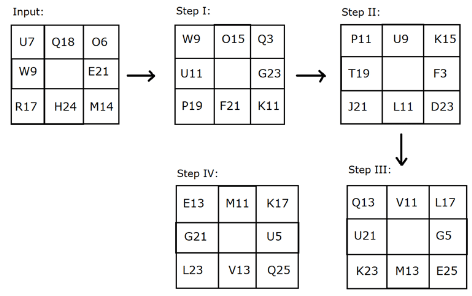
Based on the step-by-step rule followed step by step find the output for the given below input.
Input:

Q. What comes in place of O15 in step III?
Directions: Below question consists of an Input followed by step by step final output. Study the following information carefully and answer the below questions.

Based on the step-by-step rule followed step by step find the output for the given below input.
Input:
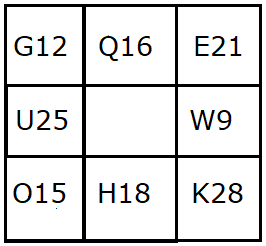
Q. If all letters from step IV are arranged in descending order based on the number followed, then which of the following combination is not true?
Directions: Below question consists of an Input followed by step by step final output. Study the following information carefully and answer the below questions.
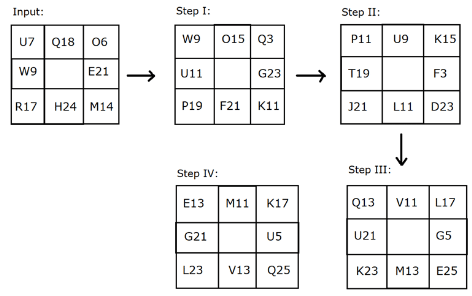
Based on the step-by-step rule followed step by step find the output for the given below input.
Input:
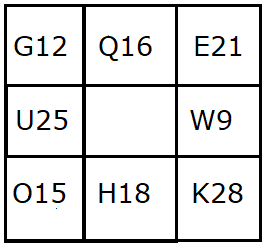
Q. What is the sum of the numbers followed by letters which comes in place of H18 and G12 in step II?
Directions: Below question consists of an Input followed by step by step final output. Study the following information carefully and answer the below questions.
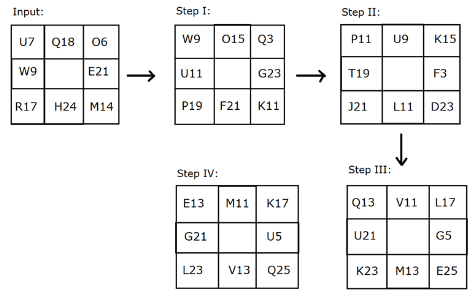
Based on the step-by-step rule followed step by step find the output for the given below input.
Input:
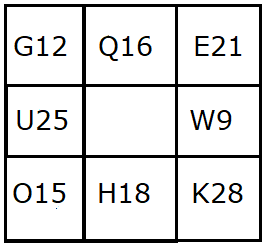
Q. What comes in place of W9 in step IV?
Directions: Study the given information carefully and answer the following question.
Ten persons were born in different years such as all of them are of different ages. Also, each of them is related to each other. All the calculations of ages are to be done based on the year 2019.
The difference between the ages of Ritika and Lovely is 9 years which is same as the difference between the ages of Tanya and Meenakshi. Nakul is 21 years old. The difference between the ages of Nakul and Meenakshi is a perfect square of 4. Only three persons are younger than Prateek. The difference between the ages of Tanya and Prateek is equal to the ages of Nakul. Meenakshi is elder to Prateek. Sonal is 11 years younger than Prateek. As many as persons are younger than Sonal as are elder as Lovely. The sum of the ages of Ritika and Sonal is 91 years. The difference between the ages of Lovely and Urvashi is equal to the age of Sonal. Qamish is 24 years younger than Urvashi. The difference between the ages of Urvashi and Qamish is same as the difference between Qamish and Opal. Ritika is just elder than Lovely. The age of the Prateek is a perfect square. The youngest person has no sibling.
Q. What is the total age of Ritika and Qamish on the basis of 2019?
Directions: Study the given information carefully and answer the following question.
Ten persons were born in different years such as all of them are of different ages. Also, each of them is related to each other. All the calculations of ages are to be done based on the year 2019.
The difference between the ages of Ritika and Lovely is 9 years which is same as the difference between the ages of Tanya and Meenakshi. Nakul is 21 years old. The difference between the ages of Nakul and Meenakshi is a perfect square of 4. Only three persons are younger than Prateek. The difference between the ages of Tanya and Prateek is equal to the ages of Nakul. Meenakshi is elder to Prateek. Sonal is 11 years younger than Prateek. As many as persons are younger than Sonal as are elder as Lovely. The sum of the ages of Ritika and Sonal is 91 years. The difference between the ages of Lovely and Urvashi is equal to the age of Sonal. Qamish is 24 years younger than Urvashi. The difference between the ages of Urvashi and Qamish is same as the difference between Qamish and Opal. Ritika is just elder than Lovely. The age of the Prateek is a perfect square. The youngest person has no sibling.
Q. What is the difference between the total age of Urvashi and Sonal and total age of Sonal and Meenakshi?
Directions: Study the given information carefully and answer the following question.
Ten persons were born in different years such as all of them are of different ages. Also, each of them is related to each other. All the calculations of ages are to be done based on the year 2019.
The difference between the ages of Ritika and Lovely is 9 years which is same as the difference between the ages of Tanya and Meenakshi. Nakul is 21 years old. The difference between the ages of Nakul and Meenakshi is a perfect square of 4. Only three persons are younger than Prateek. The difference between the ages of Tanya and Prateek is equal to the ages of Nakul. Meenakshi is elder to Prateek. Sonal is 11 years younger than Prateek. As many as persons are younger than Sonal as are elder as Lovely. The sum of the ages of Ritika and Sonal is 91 years. The difference between the ages of Lovely and Urvashi is equal to the age of Sonal. Qamish is 24 years younger than Urvashi. The difference between the ages of Urvashi and Qamish is same as the difference between Qamish and Opal. Ritika is just elder than Lovely. The age of the Prateek is a perfect square. The youngest person has no sibling.
Q. How many persons are born between Tanya and Prateek?
Directions: Study the given information carefully and answer the following question.
Ten persons were born in different years such as all of them are of different ages. Also, each of them is related to each other. All the calculations of ages are to be done based on the year 2019.
The difference between the ages of Ritika and Lovely is 9 years which is same as the difference between the ages of Tanya and Meenakshi. Nakul is 21 years old. The difference between the ages of Nakul and Meenakshi is a perfect square of 4. Only three persons are younger than Prateek. The difference between the ages of Tanya and Prateek is equal to the ages of Nakul. Meenakshi is elder to Prateek. Sonal is 11 years younger than Prateek. As many as persons are younger than Sonal as are elder as Lovely. The sum of the ages of Ritika and Sonal is 91 years. The difference between the ages of Lovely and Urvashi is equal to the age of Sonal. Qamish is 24 years younger than Urvashi. The difference between the ages of Urvashi and Qamish is same as the difference between Qamish and Opal. Ritika is just elder than Lovely. The age of the Prateek is a perfect square. The youngest person has no sibling.
Q. Four of the following five are alike in a certain way, based on their position. Which of the following does not belongs to that group?
Directions: Study the given information carefully and answer the following question.
Ten persons were born in different years such as all of them are of different ages. Also, each of them is related to each other. All the calculations of ages are to be done based on the year 2019.
The difference between the ages of Ritika and Lovely is 9 years which is same as the difference between the ages of Tanya and Meenakshi. Nakul is 21 years old. The difference between the ages of Nakul and Meenakshi is a perfect square of 4. Only three persons are younger than Prateek. The difference between the ages of Tanya and Prateek is equal to the ages of Nakul. Meenakshi is elder to Prateek. Sonal is 11 years younger than Prateek. As many as persons are younger than Sonal as are elder as Lovely. The sum of the ages of Ritika and Sonal is 91 years. The difference between the ages of Lovely and Urvashi is equal to the age of Sonal. Qamish is 24 years younger than Urvashi. The difference between the ages of Urvashi and Qamish is same as the difference between Qamish and Opal. Ritika is just elder than Lovely. The age of the Prateek is a perfect square. The youngest person has no sibling.
Q. Who among the following was born just before 1973?
Directions: Study the following information carefully and answer the question given below-
Six persons have different numbers of boxes also these boxes are placed one above another. Each box contains different number of items. The box which is of Rahul is placed immediately above box F. Only two boxes are placed between the box which contains 23 pens and the box given to Rahul. Total number of items contained by the box which is of Kapil is 10 less than the one which is of Geeta. The total number of items in the box which is of Neha is 2 more than the number of pens contain in box F. The box which contains 23 pens is placed above box F. Box C does not contain 23 pens. The boxes which is of Kusum and Neha is kept below the box containing 23 pens. Only one box is kept between box C and the box containing 20 pens. Box B contains total 39 items. Only one box is placed between box B and the box which is of Santosh. Two boxes are kept between the boxes which is of Kusum and Neha. Box C is neither of Kusum nor Neha. The box which contains 20 pens is neither of Kusum nor Neha. The box which is of Kusum contains total 17 items. Box E belongs to Kapil. The box which is placed immediately above box A contains 6 pencils. Box A is of neither Geeta nor Kusum. The box which is of Santosh and box B contain total 56 pens. The box which contains 15 pencils is placed immediately above the box which contains 25 pencils. Box E does not contain 20 pens. Box B is placed below box which is of Santosh. Box D and E contain total 18 pencils. Total number of pens in box F and A is 52.
Q. Which of the following box is kept immediately below box E?
Directions: Study the following information carefully and answer the question given below-
Six persons have different numbers of boxes also these boxes are placed one above another. Each box contains different number of items. The box which is of Rahul is placed immediately above box F. Only two boxes are placed between the box which contains 23 pens and the box given to Rahul. Total number of items contained by the box which is of Kapil is 10 less than the one which is of Geeta. The total number of items in the box which is of Neha is 2 more than the number of pens contain in box F. The box which contains 23 pens is placed above box F. Box C does not contain 23 pens. The boxes which is of Kusum and Neha is kept below the box containing 23 pens. Only one box is kept between box C and the box containing 20 pens. Box B contains total 39 items. Only one box is placed between box B and the box which is of Santosh. Two boxes are kept between the boxes which is of Kusum and Neha. Box C is neither of Kusum nor Neha. The box which contains 20 pens is neither of Kusum nor Neha. The box which is of Kusum contains total 17 items. Box E belongs to Kapil. The box which is placed immediately above box A contains 6 pencils. Box A is of neither Geeta nor Kusum. The box which is of Santosh and box B contain total 56 pens. The box which contains 15 pencils is placed immediately above the box which contains 25 pencils. Box E does not contain 20 pens. Box B is placed below box which is of Santosh. Box D and E contain total 18 pencils. Total number of pens in box F and A is 52.
Q. How many pens are kept in box F?
Directions: Study the following information carefully and answer the question given below-
Six persons have different numbers of boxes also these boxes are placed one above another. Each box contains different number of items. The box which is of Rahul is placed immediately above box F. Only two boxes are placed between the box which contains 23 pens and the box given to Rahul. Total number of items contained by the box which is of Kapil is 10 less than the one which is of Geeta. The total number of items in the box which is of Neha is 2 more than the number of pens contain in box F. The box which contains 23 pens is placed above box F. Box C does not contain 23 pens. The boxes which is of Kusum and Neha is kept below the box containing 23 pens. Only one box is kept between box C and the box containing 20 pens. Box B contains total 39 items. Only one box is placed between box B and the box which is of Santosh. Two boxes are kept between the boxes which is of Kusum and Neha. Box C is neither of Kusum nor Neha. The box which contains 20 pens is neither of Kusum nor Neha. The box which is of Kusum contains total 17 items. Box E belongs to Kapil. The box which is placed immediately above box A contains 6 pencils. Box A is of neither Geeta nor Kusum. The box which is of Santosh and box B contain total 56 pens. The box which contains 15 pencils is placed immediately above the box which contains 25 pencils. Box E does not contain 20 pens. Box B is placed below box which is of Santosh. Box D and E contain total 18 pencils. Total number of pens in box F and A is 52.
Q. How many total number of pens are kept in box D and A?
Directions: Study the following information carefully and answer the question given below-
Six persons have different numbers of boxes also these boxes are placed one above another. Each box contains different number of items. The box which is of Rahul is placed immediately above box F. Only two boxes are placed between the box which contains 23 pens and the box given to Rahul. Total number of items contained by the box which is of Kapil is 10 less than the one which is of Geeta. The total number of items in the box which is of Neha is 2 more than the number of pens contain in box F. The box which contains 23 pens is placed above box F. Box C does not contain 23 pens. The boxes which is of Kusum and Neha is kept below the box containing 23 pens. Only one box is kept between box C and the box containing 20 pens. Box B contains total 39 items. Only one box is placed between box B and the box which is of Santosh. Two boxes are kept between the boxes which is of Kusum and Neha. Box C is neither of Kusum nor Neha. The box which contains 20 pens is neither of Kusum nor Neha. The box which is of Kusum contains total 17 items. Box E belongs to Kapil. The box which is placed immediately above box A contains 6 pencils. Box A is of neither Geeta nor Kusum. The box which is of Santosh and box B contain total 56 pens. The box which contains 15 pencils is placed immediately above the box which contains 25 pencils. Box E does not contain 20 pens. Box B is placed below box which is of Santosh. Box D and E contain total 18 pencils. Total number of pens in box F and A is 52.
Q. Which of the following box contain 17 items?
Directions: Study the following information carefully and answer the question given below-
Six persons have different numbers of boxes also these boxes are placed one above another. Each box contains different number of items. The box which is of Rahul is placed immediately above box F. Only two boxes are placed between the box which contains 23 pens and the box given to Rahul. Total number of items contained by the box which is of Kapil is 10 less than the one which is of Geeta. The total number of items in the box which is of Neha is 2 more than the number of pens contain in box F. The box which contains 23 pens is placed above box F. Box C does not contain 23 pens. The boxes which is of Kusum and Neha is kept below the box containing 23 pens. Only one box is kept between box C and the box containing 20 pens. Box B contains total 39 items. Only one box is placed between box B and the box which is of Santosh. Two boxes are kept between the boxes which is of Kusum and Neha. Box C is neither of Kusum nor Neha. The box which contains 20 pens is neither of Kusum nor Neha. The box which is of Kusum contains total 17 items. Box E belongs to Kapil. The box which is placed immediately above box A contains 6 pencils. Box A is of neither Geeta nor Kusum. The box which is of Santosh and box B contain total 56 pens. The box which contains 15 pencils is placed immediately above the box which contains 25 pencils. Box E does not contain 20 pens. Box B is placed below box which is of Santosh. Box D and E contain total 18 pencils. Total number of pens in box F and A is 52.
Q. How many pencils are kept in a box placed exactly between Box C and Box B?
Directions: Read the paragraph given below and answer the questions based on the same that follow
There are lots of good reasons to encourage walking and cycling – active travel, as it’s called. The pandemic necessitates social distancing on public transport, which means buses and trains have to ferry fewer passengers per journey. Cycling and walking are healthier alternatives and in the longer term, both have a part to play in cutting carbon emissions from the transport system, as well as improving urban air quality.
Q. Which of the following can be inferred from the given paragraph?
Directions: Read the paragraph given below and answer the questions based on the same that follow
There are lots of good reasons to encourage walking and cycling – active travel, as it’s called. The pandemic necessitates social distancing on public transport, which means buses and trains have to ferry fewer passengers per journey. Cycling and walking are healthier alternatives and in the longer term, both have a part to play in cutting carbon emissions from the transport system, as well as improving urban air quality.
Q. Which of the following assumptions would weaken the idea being presented in the passage?
Directions: Below question consists of an input and some output following a certain rule. Study the following information carefully and answer the below questions.
Input: K % 5 G > E 3 @ Y 8 9 & D 2 ^ I 4 # A 1 L £ U 6
Step I: K % 5 G > E 3 Y 8 9 @ D 2 ^ & I 4 # A 1 L £ U 6
Step II: 2 ^ & I 4 # A 1 L £ U 6 D @ 9 8 Y 3 E > G 5 % K
Step III: A 1 L £ U 6 # 4 I & ^ 2E > G 5 % K 3 Y 8 9 @ D
Q. Which of the following element is seventeenth from the right end of step II?
Input: @ Y K 5 % 8 > G E 3 D 2 ^ I A 1 9 & 4 # L £ U 6
Directions: Below question consists of an input and some output following a certain rule. Study the following information carefully and answer the below questions.
Input: K % 5 G > E 3 @ Y 8 9 & D 2 ^ I 4 # A 1 L £ U 6
Step I: K % 5 G > E 3 Y 8 9 @ D 2 ^ & I 4 # A 1 L £ U 6
Step II: 2 ^ & I 4 # A 1 L £ U 6 D @ 9 8 Y 3 E > G 5 % K
Step III: A 1 L £ U 6 # 4 I & ^ 2E > G 5 % K 3 Y 8 9 @ D
Q. How many letters are immediately followed by a number in step III?
Input: 5 % G >1 £ U 6 W 8 @ O 9 & L E 3 ^ D 2 # K I A


